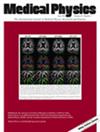Fraction-variant beam orientation optimization for spatiotemporal fractionation schemes
Abstract
Background
Spatiotemporal fractionation schemes aim at partial hypofractionation in the tumor along with more uniform fractionation in the normal tissue. This is achieved by delivering distinct dose distributions in different fractions, where each fraction contributes with high doses to complementary parts of target volume, while similar dose baths are delivered to the normal tissue.
Purpose
In this study, we extend spatiotemporal fractionation schemes by allowing for different non-coplanar beam orientations in each fraction. As different regions of the target volume are treated in different fractions, spatiotemporal fractionation schemes may benefit from selecting different beam orientations in each fraction.
Methods
Spatiotemporally fractionated (STF) treatments are generated using a novel biologically effective dose (BED)-based direct aperture optimization (DAO) algorithm, which allows for the simultaneous optimization of multiple-dose distributions to be delivered in the different fractions along with their corresponding sets of multileaf collimated apertures and monitor unit (MU) weights. Each set of apertures specifies a series of control points along a fraction-specific non-coplanar dynamic trajectory, which consists of a 360° gantry arc with dynamic bi-directional couch rotation. The gantry-couch path is automatically determined during the treatment plan optimization. The proposed DAO approach is demonstrated for stereotactic body radiotherapy (SBRT) of a patient with liver metastases (3 × 12 Gy, patient 1) and stereotactic radiotherapy (SRT) of a patient with a large arteriovenous malformation (AVM) (4 × 7 Gy, patient 2).
Results
For both patients, STF treatments deliver highly non-uniform dose distributions in distinct fractions. Depending on which region of the target volume is irradiated in each fraction, very different non-coplanar dynamic trajectories are selected. For a similar target coverage, the STF treatment obtained using fraction-specific non-coplanar dynamic trajectories reduces the mean liver BED3 in patient 1 by 13.7% (32.9 Gy vs. 38.1 Gy) and the mean brain BED2 in patient 2 by 18.4% (5.15 Gy vs. 6.31 Gy), respectively, compared to a STF treatment obtained using coplanar VMAT arcs in every fraction.
Conclusions
The dosimetric quality of STF treatments can be considerably enhanced by selecting different non-coplanar beam orientations in different fractions, which are beneficial to treat specific parts of the target volume.


 求助内容:
求助内容: 应助结果提醒方式:
应助结果提醒方式:


